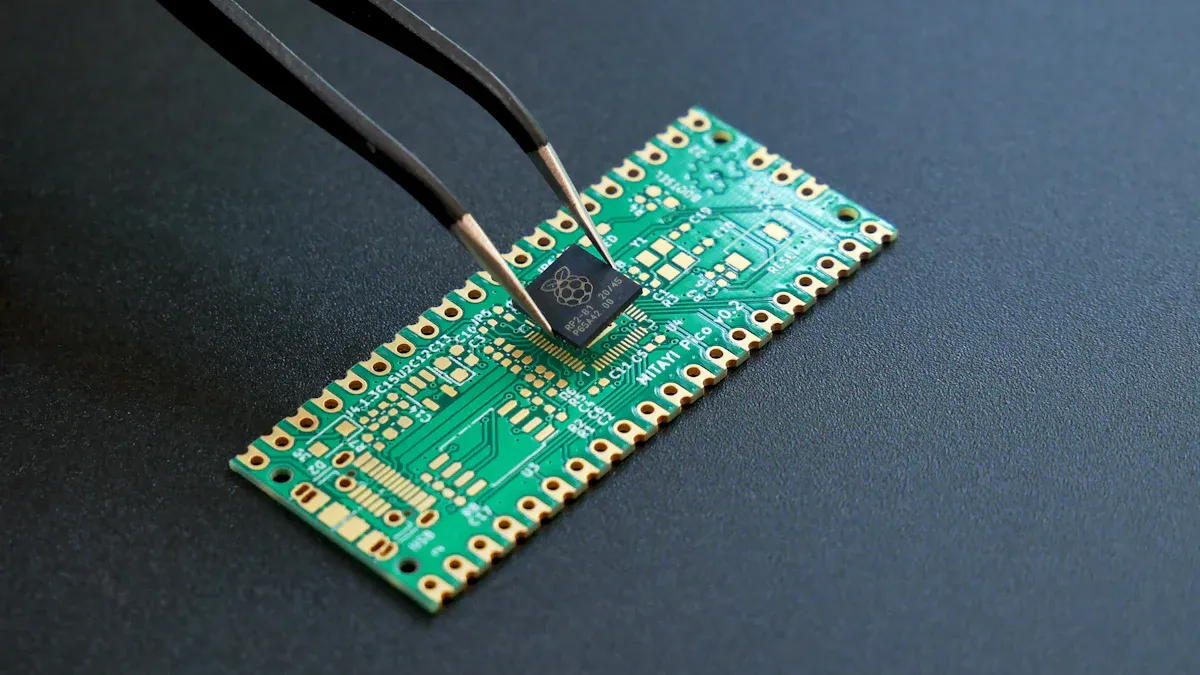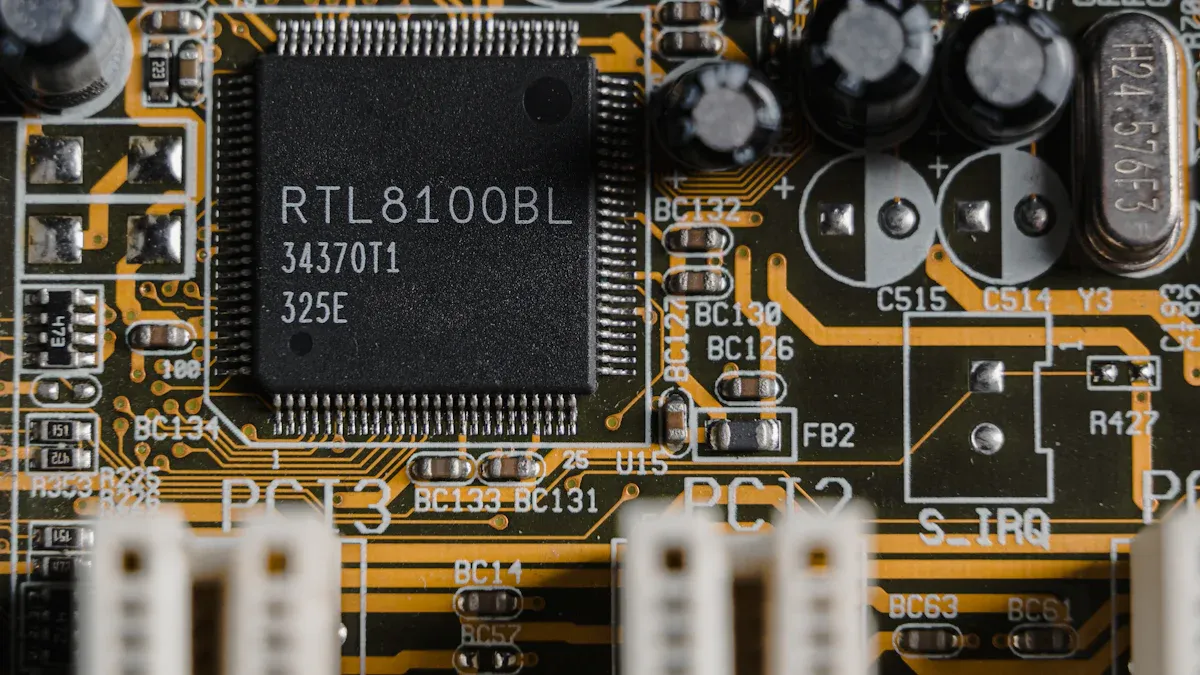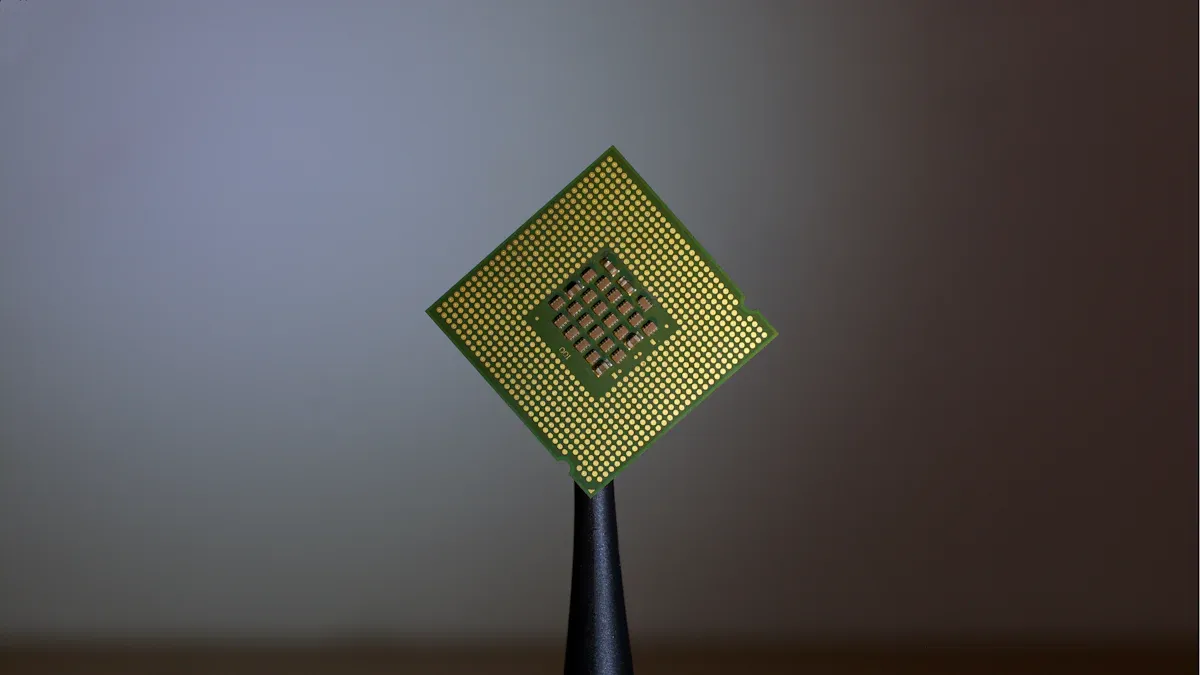What Is an Integrated Circuit and How Does It Work

You often hear the term integrated circuit, also called a chip or microchip. An ic circuit is a small piece of silicon that holds many tiny electronic parts. These parts include transistors, resistors, and capacitors. You find these circuits in almost every electronic device you use. They help your devices work quickly and reliably.
Key Takeaways
Integrated circuits are tiny chips made of silicon that hold many small electronic parts working together to power your devices.
These chips combine parts like transistors, resistors, capacitors, and diodes to perform tasks such as signal processing, data storage, and logical operations.
ICs come in three main types: digital, analog, and mixed-signal, each handling different kinds of electronic signals and functions.
The integration of many parts on one chip makes devices faster, smaller, more reliable, and energy-efficient.
You use integrated circuits every day in phones, computers, cars, and many other gadgets that run smoothly because of these powerful chips.
IC Circuit Basics
What Is an IC Circuit
When you hear the term ic circuit, you might also hear people call it a chip or microchip. An ic circuit is a tiny electronic system built on a thin slice of silicon. Silicon is the main material because it works well as a semiconductor. Manufacturers use silicon wafers, which they cut from large silicon ingots. They polish and process these wafers through steps like layering, patterning, etching, and doping. This process creates the complex structures inside each ic circuit.
Silicon stands out because it forms silicon dioxide, an important insulating layer. This layer helps separate different parts of the circuit and keeps signals from mixing. Silicon also has strong mechanical properties. It works well with the tools and chemicals used to make ic circuits. Other materials, such as copper, silver, and magnesium, help connect the parts inside the chip, but silicon forms the base.
Key Features
An ic circuit packs many tiny electronic parts into one small chip. These parts work together to perform important tasks in your devices. The main components inside an ic circuit include transistors, diodes, resistors, and capacitors. Each part has a special job. You can see their roles in the table below:
Component | Role/Function |
|---|---|
Transistors | Act as switches or amplifiers, enabling logic operations and signal amplification |
Diodes | Control current flow, allowing signals to move in one direction or modulate signals |
Resistors | Control current and voltage levels, used in timing and biasing circuits |
Capacitors | Store and release electrical energy, used in timing, filtering, and oscillation |
You find these components connected inside the silicon chip. Thin lines of copper or gold link them together. The ic circuit can then perform many different functions in your electronic devices.
Note: The small size of an ic circuit allows you to fit powerful technology into phones, computers, and even cars.
Some of the main functions that ic circuits perform include:
Processing signals, both analog and digital, for tasks like amplification and computation
Storing data and instructions for your devices
Performing logical operations, which help devices make decisions
Managing communication between different parts of a device or between devices
Here is a quick overview of what ic circuits do in modern electronics:
Primary Functions of Integrated Circuits | Description |
|---|---|
Signal Processing | ICs process analog and digital signals, enabling amplification, regulation, and complex computations. |
Data Storage | ICs store data and instructions essential for device operation. |
Logical Operations | Perform basic to complex logic tasks within devices. |
Communication Interfaces | Manage wireless and wired signal transmission in devices like smartphones. |
You rely on ic circuits every day, even if you do not see them. They help your devices run smoothly, quickly, and efficiently.
Structure and Components

Silicon Chip
You might wonder how an integrated circuit starts its life. The process begins with a silicon ingot, which grows from a single seed crystal dipped into molten silicon. Manufacturers slice this ingot into thin wafers and polish them until they shine like a mirror. Next, they use photolithography to create patterns on the wafer’s surface. Here’s a simple breakdown of the steps:
Slice the ingot into thin wafers.
Polish the wafers to a mirror finish.
Use photolithography to pattern the wafer.
Diffuse chemical dopants into the wafer in high-temperature furnaces.
Deposit metal onto the wafer surface.
Etch away unwanted metal to form connections.
Test the completed wafers.
Cut the wafers into individual chips.
Assemble the chips into protective packages.
This process creates the base for every integrated circuit you use.
Internal Components
Inside each silicon chip, you find a network of tiny electronic parts. The most important components include:
Transistors: Act as switches or amplifiers, controlling the flow of electricity.
Resistors: Limit or control the amount of current in a circuit.
Capacitors: Store and release electrical energy when needed.
Diodes: Allow current to flow in only one direction.
These parts work together to perform complex tasks. You can think of them as the building blocks that let your devices process information, store data, and communicate.
Interconnects and Pins
To connect the chip to the outside world, manufacturers use interconnects and pins. The pins are the silver terminals you see on the outside of a chip package. Each pin connects to the chip’s internal die using tiny gold wires. This setup lets electrical signals move between the chip and other parts of your device.
Pins serve as the main interface for communication.
Different package types, like Dual Inline Package (DIP) and Surface-Mount Technology (SMT), affect how pins attach to circuit boards.
DIP pins go through holes in the board, making them easy to handle.
SMT pins sit flat on the board, saving space and allowing for automated assembly.
Pinouts define the number and function of each pin, such as power, ground, or data. Choosing the right pin configuration helps your device work safely and efficiently.
How IC Circuits Work
Working Principle
You might wonder how an ic circuit can do so many things inside your devices. The secret lies in how it brings together millions of tiny electronic parts on a single piece of silicon. These parts include transistors, diodes, resistors, and capacitors. When you connect them in special ways, they can handle complex electronic tasks. The silicon chip acts as a base, holding all these parts close together. This setup lets the components work as a team, passing signals and power quickly and efficiently.
The main idea behind an ic circuit is integration. You combine many electronic parts into one small chip. This integration allows the chip to perform tasks like amplifying signals, storing data, and making decisions. The use of silicon as a semiconductor makes this possible. Silicon lets the components switch on and off, control current, and store information. Because everything sits on one chip, the ic circuit works faster and uses less power than separate parts would.
When you use a phone or computer, you benefit from this integration. Your device runs faster, lasts longer on a charge, and rarely breaks down because the ic circuit keeps everything working smoothly.
You can see how integration improves performance and efficiency in the table below:
Benefit/Mechanism | Explanation | Example/Impact |
|---|---|---|
No need for separate power supplies or extra wires, so less energy is wasted. | Phones last longer between charges. | |
Enhanced Performance | Parts work close together, so signals travel faster. | Apps open quickly and run smoothly. |
Cost Savings | Fewer parts and easier assembly lower the price. | More people can afford smart devices. |
Compact Form Factor | Everything fits in a small space. | Smartwatches and earbuds stay tiny and light. |
Improved Reliability | Fewer connections mean fewer things can go wrong. | Devices break less often and last longer. |
Seamless Integration | All parts work together without problems. | Cars and medical devices use ic circuits for safety and control. |
Optimized Power Management | The chip can adjust power use based on what you do. | Tablets and laptops save energy when not in use. |
Case Study | Apple’s A-series chips combine many parts for speed and battery life. | iPhones run fast and stay cool, even with heavy use. |
Common Functions
An ic circuit can perform many different jobs inside your electronics. Each job depends on how you arrange the tiny parts inside the chip. Here are some of the most common functions you will find:
Amplification: The chip can make weak signals stronger. For example, it boosts sound in your headphones.
Oscillation: It can create repeating signals, like the ticking in a digital clock.
Counting: The chip can count events, such as button presses or time intervals.
Voltage Regulation: It keeps the voltage steady, protecting your device from power spikes.
Timing: The chip can keep track of time, helping your alarm clock or timer work.
Memory Storage: It can store information, like your photos or game scores.
You can see how different types of ic circuits enable these functions in the table below:
IC Type | Components and Characteristics | Functions Enabled |
|---|---|---|
Use transistors, resistors, capacitors, and diodes; output changes smoothly with input | Amplification (music players), Oscillation (timers) | |
Digital ICs | Use logic gates that work with 0s and 1s | Memory storage (computers), digital processing |
Microprocessors | Contain registers and counters | Store and process instructions and data (smartphones) |
Tip: The same ic circuit can sometimes handle more than one function. For example, a microprocessor can store data, process information, and control other parts of your device.
When you use a calculator, listen to music, or play a video game, you rely on ic circuits to make everything work. These chips handle signals, store your data, and keep your devices running smoothly.
Types of IC Circuits

Integrated circuits come in three main types: digital, analog, and mixed-signal. Each type has special features and uses in your devices. You can see the main differences in the table below:
Type of IC | Main Characteristics | Examples and Key Functions |
|---|---|---|
Analog ICs | Handle continuously varying signals | Operational amplifiers, comparators, voltage reference ICs, analog filters, RF ICs |
Digital ICs | Perform discrete logic operations | Logic gates, flip-flops, memory (DRAM, SRAM, flash), microcontrollers, digital signal processors, FPGAs |
Mixed-Signal ICs | Combine analog and digital functionalities | Analog-to-digital converters (ADCs), digital-to-analog converters (DACs), SoC designs |
Digital ICs
Digital ICs work with signals that have only two values: 0 and 1. You use these chips in devices that need to process, store, or move digital data. Digital ICs include logic gates, memory chips, microcontrollers, and digital signal processors. Microprocessors are the most complex digital ICs. They act as the "brains" of computers and smartphones. A microprocessor fetches, decodes, and runs instructions from memory. It contains many parts, such as arithmetic logic units and control units, all packed into one chip. This design lets your device run apps, play games, and connect to the internet.
Digital ICs make your devices smart and fast. You find them in computers, tablets, cameras, and even cars.
Analog ICs
Analog ICs handle signals that change smoothly over time, like sound, light, or temperature. These chips help your devices sense the real world. You find analog ICs in amplifiers, voltage regulators, and filters. For example, an amplifier chip boosts the sound from your phone’s microphone. Analog ICs must keep signals clean and accurate, even when there is noise. They play a key role in medical devices, radios, and audio equipment.
Analog ICs process real-world signals.
They help with tasks like signal amplification, voltage control, and filtering.
Mixed-Signal ICs
Mixed-signal ICs combine both analog and digital parts on a single chip. You use these chips when your device needs to work with both real-world signals and digital data. For example, a mixed-signal IC can turn sound into digital data for your phone to process, or change digital music back into sound for your headphones. These chips use special designs to keep digital noise from affecting sensitive analog parts. Mixed-signal ICs appear in smartwatches, cars, and wireless devices.
Mixed-signal ICs enable analog-to-digital and digital-to-analog conversions.
They help reduce the size and power use of your devices by combining many functions in one chip.
Tip: Mixed-signal ICs are important for devices that need to sense, process, and communicate with the world around them.
Applications and Impact
Everyday Devices
You use integrated circuits every day, often without even noticing. These tiny chips power many of the devices you rely on at home, at school, and on the go. Integrated circuits help your gadgets work faster, smarter, and more efficiently. Here are some of the most common devices that depend on ICs:
Computing devices including computers, laptops, tablets, and smartphones
Automotive electronics like vehicle control, safety, and infotainment systems
You find ICs inside your TV, making the picture clear and the sound crisp. Your phone uses several ICs to connect to the internet, run apps, and take photos. Cars use ICs to control safety features, manage fuel use, and provide entertainment. Even your smartwatch tracks your steps and heart rate with the help of these chips.
Tip: The next time you use a remote control, play a video game, or listen to music, remember that integrated circuits make it all possible.
Importance in Technology
Integrated circuits have changed the way you experience technology. They allow engineers to fit more power and features into smaller devices. This process is called miniaturization. You benefit from lighter, faster, and more portable gadgets because of ICs. Here are some ways ICs make this possible:
ICs combine many electronic parts into one chip, reducing size, weight, and power use.
System-on-Chip (SoC) technology puts entire subsystems—like processors and memory—on a single chip.
Advanced manufacturing packs more transistors into smaller spaces, boosting speed and efficiency.
3D stacking saves space by building chips upward, not just outward.
Miniaturization leads to smaller, portable, and more efficient devices in electronics, cars, and medical tools.
Shorter signal paths increase speed, while lower power use means longer battery life.
SoCs let you enjoy multifunctional devices, like smartphones that act as cameras, computers, and music players.
ICs also make your devices more reliable and powerful. The table below shows how ICs improve different areas of technology:
Application Area | Impact on Reliability and Performance |
|---|---|
ICs enable faster and more efficient data transmission, supporting high-speed mobile networks (4G, 5G) and stable connectivity. | |
Consumer Electronics | ICs control and manage device functions, improving smart features, energy efficiency, and operational precision. |
Medical Devices | ICs enhance accuracy and quality in health monitoring and diagnostic equipment by precise signal processing. |
Automotive Systems | ICs improve safety and comfort by managing engine control, fuel efficiency, and safety features like anti-lock brakes. |
Digital ICs | Provide high processing speed, precision, reliability, compact size, and low power consumption. |
Analog ICs | Handle continuous signals with complex design, used in communication and control systems. |
Mixed-Signal ICs | Combine digital speed and precision with analog continuous signal processing, enabling complete system integration on one chip. |
You can see that integrated circuits shape the technology you use every day. They make your devices smaller, faster, and more dependable.
Integrated circuits, or ICs, bring together many tiny parts on a single chip to power your favorite devices. You see their impact every day:
ICs make smartphones, computers, and appliances smarter and more efficient.
They enable features like AI, 5G, and high-quality gaming.
ICs help cars, medical devices, and even smart clothing work better.
When you understand how ICs shape technology, you can appreciate the amazing devices you use and look forward to even more exciting advances in the future.
FAQ
What is the main advantage of using integrated circuits?
You get smaller, faster, and more reliable devices with integrated circuits. ICs use less power and cost less to make. This lets you enjoy advanced technology in everyday items like phones, computers, and cars.
How do you identify an IC on a circuit board?
You can spot an IC as a small black rectangle with metal pins on the sides. These pins connect the chip to the board. Labels or numbers on the top help you find the exact type of IC.
Can you repair a damaged integrated circuit?
You usually cannot repair a damaged IC. You need to replace it with a new one. Special tools help remove the old chip and install the new one safely.
Why do ICs use silicon?
Silicon works well as a semiconductor. It controls electricity inside the chip. Silicon also handles heat and lasts a long time. This makes it the best choice for building ICs.
What happens if an IC overheats?
If an IC gets too hot, it may stop working or break. You can prevent this by using heat sinks or cooling fans. Always keep your devices cool for the best performance.
See Also
Exploring The Functionality Of Fully Integrated Processors
Understanding How Computer Chips Operate And Function
The Importance Of Integrated Circuits In Today’s Electronics
How Integrated Battery Monitor ICs Manage Power Efficiently
Real Time Microcontroller ICs And Their Operational Mechanisms
